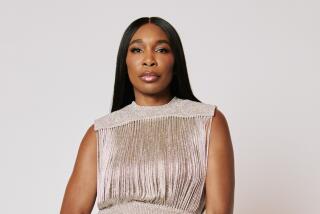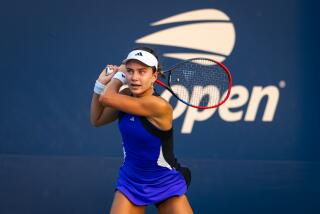Williams Still Hot in the Desert
- Share via
INDIAN WELLS, Calif. — In the exactly one year since Venus Williams had her first real tennis coming-out party here at the State Farm Evert Cup, she has lived a lifetime.
The 17-year-old from Palm Beach Gardens, Fla., by way of Lynwood, has:
* Made the U.S. Open final, slugging her way to last September’s title match against Martina Hingis;
* Won more than half a million dollars on the Women’s Tennis Assn. tour, including $466,863 last year;
* Moved to the doorstep of a top-10 world ranking, entering this event at No. 12;
* Received perhaps the most famous bump in tennis history, at least since John McEnroe’s parents dropped him on his head as a child.
For Williams, it has all happened so fast that it borders on the unbelievable.
A year ago, she battled her way through the qualifying draw to get into the main bracket here. She was ranked No. 211 at the time and the only things people knew about her were that her father, Richard, had made her into some sort of whispered-about prodigy on the cracked and dusty public courts of Compton and that she wore beads in her braided hair.
Then she came here and beat Croatia’s Iva Majoli, at the time No. 9 in the world and only two months from winning the French Open, and followed that by participating in the best match of the ’97 combined Evert Cup/Newsweek Champions Cup event, a third-set tiebreaker loss to eventual champion Lindsay Davenport. Those who watched that one, and watched huge-hitting Davenport being frequently outhit from the baseline, could see the possibility of a great future for Williams.
But nobody was predicting U.S. Open finals six months later. Nor could anyone predict the level of celebrity already reached by the young woman still four months shy of her 18th birthday.
Tuesday night, after pinning a 6-4, 6-1 loss on a game but overmatched Dominique Van Roost of Belgium, who at No. 15 is only three slots below Williams’ ranking, she signed hundreds of autographs, did the mandatory press interviews and headed back out, after 9 p.m., to play doubles on the Clubhouse court with her sister, Serena.
As it became known that the Williams sisters were getting set to play, against Hingis and Mirjana Lucic, the Stadium court virtually emptied and the Clubhouse court became a human traffic jam. Left with perhaps 200 people watching them in an arena that seats 11,500 and had 7,143 of those seats sold for the session were Germany’s Nicolas Kiefer, currently No. 1 in his country, and veteran American MaliVai Washington, 1996 Wimbledon runner-up.
Certainly, Hingis, the No. 1 women’s player, was a huge part of the draw. But it was hard disputing that the Williams sisters were causing the bigger buzz.
Ever since the famous cross-over collision between Williams and Irina Spirlea during the U.S. Open semifinals--and the controversial aftermath that included foul language by the Romanian in reference to Williams and a charge of racism by Williams’ father--the public hasn’t been quite sure what to make of Williams. That might be changing.
Tuesday night, she handled the press well, touching intelligently on, among other things, the subject of her newfound celebrity.
“I don’t think people understand to what degree you have to be patient,” she said. “People always want pictures, autographs. I understand that because I probably would want one too. But sometimes, there’s only so much one person can do.”
She is also starting to impress, and be accepted by, more and more of the tennis establishment. The WTA has a mentoring system for its younger players. Williams had her choice of mentors and chose, quite smartly, the only other women’s player of recent vintage to reach a U.S. Open final in her tournament debut, Pam Shriver. And when Shriver speaks, tennis listens.
“I like her,” Shriver said Tuesday night. “I like her a lot.”
More to Read
Go beyond the scoreboard
Get the latest on L.A.'s teams in the daily Sports Report newsletter.
You may occasionally receive promotional content from the Los Angeles Times.











